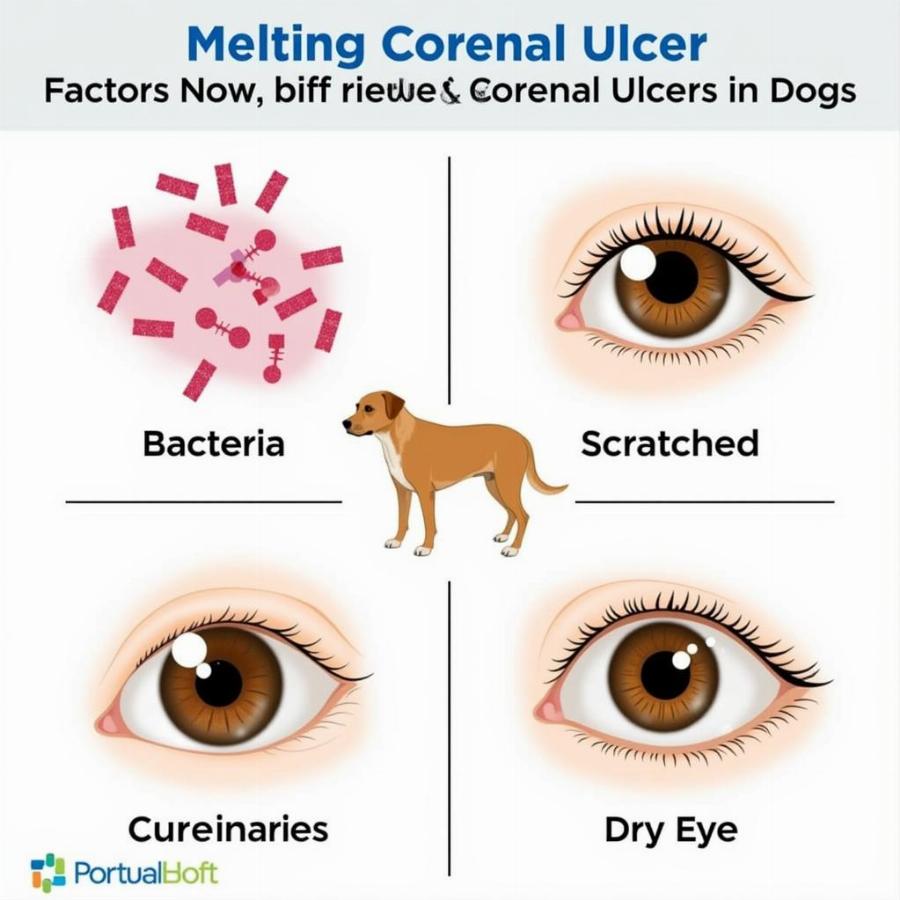Melting corneal ulcers, also known as keratomalacia, are a serious eye condition in dogs that requires immediate veterinary attention. This condition involves the progressive and rapid deterioration of the cornea, the clear front part of the eye. If left untreated, a melting corneal ulcer can lead to vision loss and even rupture of the eye. Understanding the causes, symptoms, and treatment options for melting corneal ulcers is crucial for any dog owner.
Understanding Melting Corneal Ulcers in Dogs
A melting corneal ulcer isn’t just a simple scratch. It’s a destructive process where the cornea begins to literally melt away. This occurs due to an excessive inflammatory response and the release of enzymes that break down the corneal tissue. Often, bacterial infections, particularly those caused by Pseudomonas aeruginosa or Streptococcus species, are implicated in this process. However, other factors like trauma, dry eye, and certain underlying health conditions can also contribute to the development of melting ulcers.
Recognizing the Symptoms of a Melting Corneal Ulcer
Early detection is key to managing melting corneal ulcers effectively. Be vigilant for the following signs:
- Excessive squinting or blinking: Your dog may squint or blink more frequently due to pain and discomfort.
- Redness and inflammation: The affected eye will appear red and inflamed.
- Cloudy or opaque cornea: A healthy cornea is clear. A melting ulcer will cause the cornea to become cloudy or opaque, sometimes with a yellowish tinge.
- Discharge from the eye: You may notice a thick, yellow-green discharge, which is a sign of infection.
- Visible depression or “melting” of the cornea: In advanced cases, the cornea may appear to have a divot or depression.
- Pain and sensitivity to light: Your dog may show signs of pain, such as pawing at the eye or avoiding bright lights.
What Causes Melting Corneal Ulcers?
As mentioned earlier, bacterial infections are a primary cause of melting ulcers. However, several other factors can predispose a dog to developing this condition:
- Trauma: Scratches, abrasions, or foreign bodies in the eye can damage the cornea and create an entry point for bacteria.
- Dry eye (Keratoconjunctivitis sicca – KCS): Insufficient tear production can leave the cornea vulnerable to infection and ulceration.
- Underlying health conditions: Certain autoimmune diseases and hormonal imbalances can increase the risk of corneal ulcers.
- Breed predisposition: Some breeds, like Boxers, Pugs, and Bulldogs, are more prone to corneal ulcers.
 Illustration depicting the various causes of melting corneal ulcers in dogs, including bacterial infection, trauma, and dry eye.
Illustration depicting the various causes of melting corneal ulcers in dogs, including bacterial infection, trauma, and dry eye.
Treatment Options for Melting Corneal Ulcers
Melting corneal ulcers require prompt and aggressive treatment to prevent further damage and preserve vision. Treatment typically involves:
- Intensive topical antibiotics: Frequent application of antibiotic eye drops or ointments is essential to combat the bacterial infection.
- Pain medication: Managing pain is crucial for your dog’s comfort and to prevent further self-trauma to the eye.
- Serum or autologous plasma: These can be used topically to promote corneal healing.
- Surgery: In severe cases, surgical intervention may be necessary to repair the cornea or remove damaged tissue.
Preventing Melting Corneal Ulcers in Dogs
While not all corneal ulcers can be prevented, you can take steps to minimize your dog’s risk:
- Regular eye exams: Early detection of eye problems is crucial for effective treatment.
- Prompt treatment of eye injuries: Seek veterinary care immediately for any eye injury, no matter how minor it seems.
- Management of dry eye: If your dog has dry eye, follow your veterinarian’s recommendations for treatment and management.
- Protect your dog’s eyes from trauma: Use appropriate eye protection for your dog when engaging in activities that could put their eyes at risk.
Conclusion
Melting corneal ulcers are a serious eye condition in dogs that requires immediate veterinary attention. Understanding the causes, symptoms, and treatment options for this condition is crucial for any dog owner. By being proactive and seeking prompt veterinary care, you can help protect your dog’s vision and overall health.
FAQs
- What is the prognosis for a dog with a melting corneal ulcer? The prognosis depends on the severity of the ulcer and how quickly treatment is initiated. Early and aggressive treatment offers the best chance for a good outcome.
- Can a melting corneal ulcer heal on its own? No, melting corneal ulcers will not heal on their own and require veterinary intervention.
- How long does it take for a melting corneal ulcer to heal? Healing time varies depending on the severity of the ulcer and the individual dog. It can take several weeks or even months for complete healing.
- Is a melting corneal ulcer painful for dogs? Yes, melting corneal ulcers are very painful.
- What should I do if I suspect my dog has a melting corneal ulcer? Contact your veterinarian immediately.
Beaut Dogs: Your Partner in Canine Care
Beaut Dogs is your trusted source for all things related to dog care. We are committed to providing dog owners with accurate, up-to-date information to help them make informed decisions about their furry companions’ health and well-being. From breed-specific information to expert advice on nutrition, training, and health care, Beaut Dogs has everything you need to keep your canine companion happy and healthy. When in need of support or clarification, reach out to us via email at [email protected] for detailed and accurate responses from the Beaut Dogs team. Visit https://beautdogs.com today to explore the wonderful world of dogs and learn how to provide the best possible care for your beloved pet.